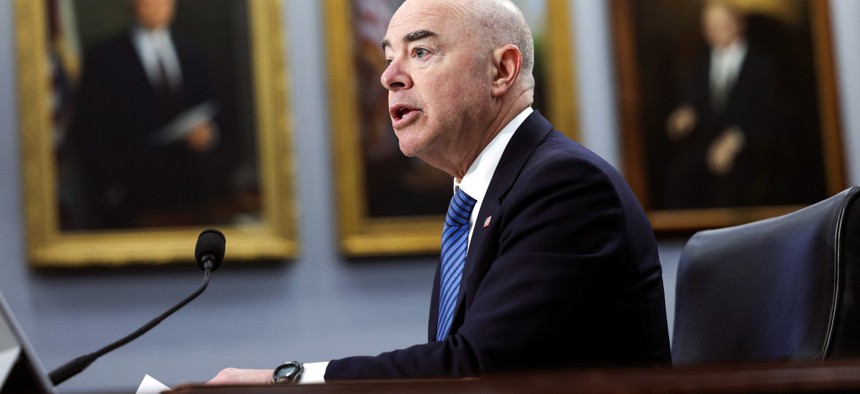
Homeland Security Secretary Alejandro Mayorkas testifies before a House Appropriations subcommittee on Wednesday. Kevin Dietsch/Getty Images
The Biden Administration Is Confident It Has the Staff to Handle the Expected Increase of Migrants at the Border
DHS is hiring contractors, deploying staff and engaging with other agencies, but says it will not sacrifice any part of its mission.
The Homeland Security Department has repositioned and reassigned its personnel to prepare for a significant increase in migrants arriving at the southern border when a pandemic-era expulsion policy is set to expire next month, with officials saying they have sufficient personnel to address the influx.
While migration levels reaching the top level of DHS’ projections would “seriously strain our capabilities,” department Secretary Alejandro Mayorkas told a panel of the House Appropriations Committee on Wednesday, he does not expect the movement of personnel to create operational gaps. To avoid such an outcome, Mayorkas said, DHS has brought on hundreds of contract personnel to handle immigrant processing, freeing up more Border Patrol agents to conduct field work. The department hired the contractors ahead of the termination of a policy known as Title 42, which the Trump administration first implemented during the COVID-19 outbreak to immediately expel undocumented migrants arriving at the border.
Customs and Border Protection has also recently deployed 600 personnel to the southwest border, DHS unveiled this week as part of its six-pillar plan to tackle the uptick in immigration anticipated when Title 42 is set to expire on May 23. The additional contractors and non-law enforcement staff hired and deployed to process immigrants will allow an additional 500 agents to return to the field. DHS is prepared to quickly add more contract personnel as necessary, Mayorkas said.
DHS, which has stressed in recent days that it has been planning for the end of Title 42 since September, previously said it would deploy officers, agents and other staff throughout its workforce to address and process the anticipated increased stream of immigrants. It also suggested it would ask for personnel assistance from other federal agencies. Encounters at the border have remained high despite Title 42 allowing the government to reject and turn away migrants seeking asylum, but the administration is expecting the news of the end of the policy will lead to a renewed interest in individuals fleeing violence, unrest and poverty seeking to enter the United States.
The exact timing of the policy’s termination could still be in flux, as a federal judge this week signaled he would soon issue an order preventing the Biden administration from taking steps to wind it down. Several states had sued seeking to keep the policy in place, saying its expiration would create chaos at the border.
Despite any DHS deployments that may take place, Mayorkas said the department’s approach will not cause other issues to fall through the cracks and the hiring of contractors “does not drain other personnel resources in the department.” The department will also take on the challenge with new resources. As part of the fiscal 2022 omnibus spending package, CBP received a 26% increase for its operations budget and U.S. Citizenship and Immigration Services saw a massive 220% funding spike to hire asylum officers and other staff and to reduce existing backlogs.
To address the expected increase, senior administration officials told reporters DHS is also building new temporary facilities and can now hold up to 18,000 migrants, a 38% increase from the start of 2021. The department is streamlining its processes for taking in migrants—such as by co-locating government and non-government entities, improving technologies and taking certain administrative steps while migrants are en transit between facilities—which in turn will in turn “allow the Border Patrol to focus more of its agents on its priority mission to secure our border rather than processing and administrative duties.” DHS will also increase its use of expedited removal, boost capacity of non-governmental organizations and better target transnational criminal organizations.
The administration is also looking to increase interagency coordination, such as leaning on the State Department to engage in diplomacy, the Defense Department to assist in quickly contracting for ground transportation and housing structures and the Health and Human Services Department to quickly transfer unaccompanied children into their custody. Mayorkas told lawmakers the Veterans Affairs Department, at VA Secretary Denis McDonough’s discretion, could also send health care staff to the border to provide medical assistance to migrants.
DHS has several times in recent years turned to its workforce to address swings in migration patterns, as well as other emergencies such as hurricane response and refugee processing. A year ago, Biden tapped the Federal Emergency Management Agency to address a record increase in migrant children at the border. FEMA, CBP, the Federal Protective Service, Immigration and Customs Enforcement and other DHS employees deployed through the department's Volunteer Force staffed shelters, provided security and offered other support. The administration subsequently asked for volunteers across government to help an overwhelmed DHS and Health and Human Services Department in processing the children. Under President Trump in 2019, CBP reassigned thousands of customs officers from ports of entry to assist Border Patrol staff during a migration upswing.
While Mayorkas expressed confidence in DHS’ capacity to move around its workforce to tackle any upswing in immigrant encounters without sacrificing other parts of its mission, he asked lawmakers to fulfill Biden’s fiscal 2023 budget request that would allow the Border Patrol to hire 300 more agents and CBP to bring on additional support personnel. Such hiring would provide resources “more enduring than mere contract personnel,” Mayorkas said.
The fate of Title 42 has become a lightning rod in recent months, as lawmakers have accused the Biden administration of failing to adequately prepare for a sharp spike in migrants. Critics of the policy have questioned whether it was ever truly intended to prevent the spread of COVID-19, the ostensible justification for its implementation.







